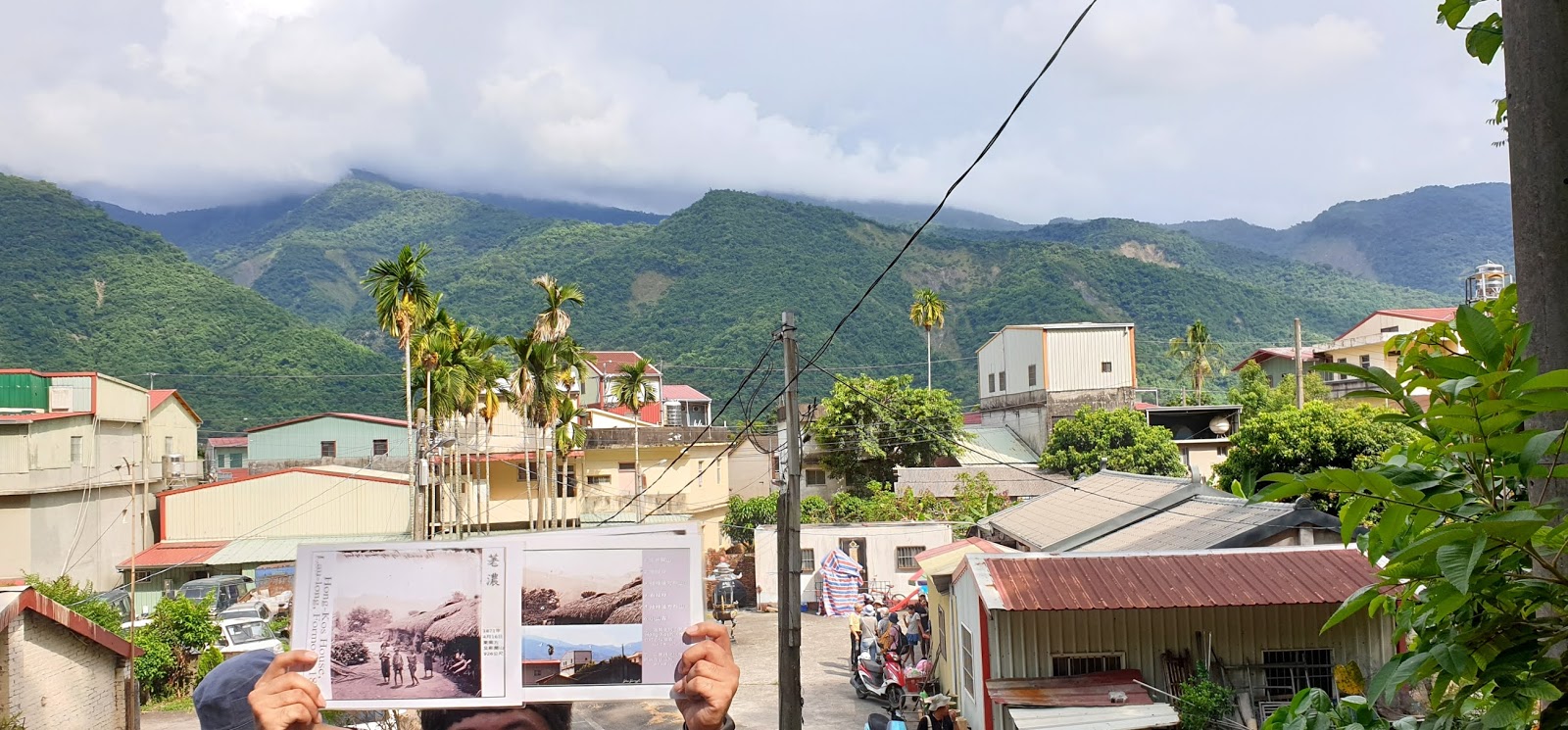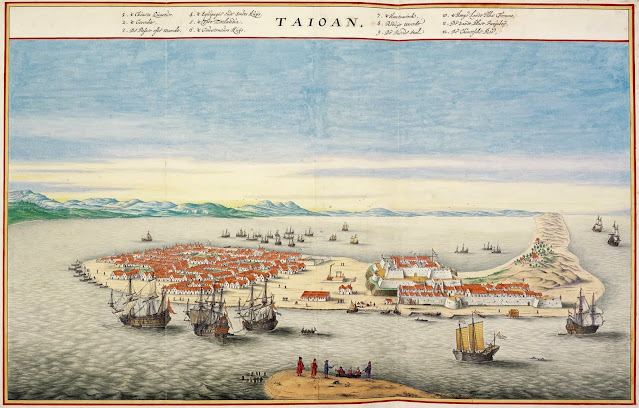John Thomson Heritage Walk Follow-up (Show and Tell)
 |
phòa pò͘ chí, “shabby rags” with eggs served on banana leaf at lunch
|
 |
| Photo credit 曾麗雲 (Jiasian People’s Association) showing her family handling the drupe in season
This post is a follow-up to a story of the above title I wrote for Taipei Times - full story HERE.
The oldest item, provided with evidence, I saw (and ate) on the day - Cordia dichotoma drupes 破布子. It gets its Holo
name (phòa pò͘ chí, “shabby rags”) because its leaves are often chewed to pieces
by insects. The drupes, known in Mandarin as shùzǐ 樹子, are smaller than peanuts and
yellowish-green when ripe. Archaeologists think cordia was consumed in quantity by the Siraya at least six hundred years ago. (fossil of this drupe is kept at Nanke Archaeological Museum Tainan)
|
 |
Dā-lāo (Sorghum nervosum var. Flexibile 散穗高粱. Tevorang taraw, Dutch taraun)
|
 |
Dā-lāo mochi. Tevorang specialty. The only 'Tevorang identity' food I saw on the day, in my opinion.
|
 |
| Tevorang wooden pestle I saw on the side of a kitchen |
A little bit more culinary details on the mochi: The grain-mix ratio the maker prefers is about 7:2 (glutinous rice: Dā-lāo) for the softer texture. Peanuts should be toasted with little bit of salt, she stressed, to balance out the sugar sweet. I personally preferred it with icing sugar and a lot of peanuts, taste and visual both delightful.
How relevant is this tour to my co-authored book "A Culinary History of Taipei" - VERY, in fact, turned out to be.
Not only was I first introduced to Mr You and this heritage program by Ahanah Nuya 阿海納 an environmental chef (as he was known in South of Taiwan) who I first got acquainted because of the book, but also this paragraph in the starting chapter gave me the idea to start the post with some of the 'oldest' and supplementing information.
By the seventeenth century, Taiwan’s indigenous peoples displayed fabulous cultural diversity. In some tribes, the women tattooed their faces; in others, they tattooed their hands. ...At a time when the island’s total population was barely one hundred thousand, more than twenty Austronesian languages were spoken. But none of them had a written form, so the only accounts that supplement oral history and archaeological evidence were written by visitors such as Chen Di. (A Culinary History of Taipei, Crook and Hung.)
And naturally, I simply would not have appreciated the walk the way I did had I not undertaken the due diligent research for the book.
Banana colloquial speech 香蕉白話
In the few minutes I have got between scheduled events, auntie Liu-Pan so warmly helped me collect some 'banana speech' which I had thought may have disappeared. Apparently this linguistic interest I expressed was not expected, nevertheless, the host managed to make it happen for me for which I am very grateful.
Upon my return to Taipei, Teng ya provided a table of the few 'banana sentences' I collected:
劉潘鳳英-只帶一些白話字的香蕉白話 (less syllables added)
|
||
翻譯
|
台灣話拼音 Taiwanese
|
香蕉白話
Banana colloquial speech
|
我要去那邊遊玩。
I am going over there to play
|
Guá-beh-khì-hia-tshit-thô.
|
Guá-beh-seh
-khì-shì-hia-sia-tshit-shit-thô-shô.
|
我沒買東西
I didn't buy things
|
Guá-bô-bé-mi̍h-kiānn.
|
Guá-bô-bé-sé-mi̍h-si̍h-kiānn-siānn.
|
不一定
not fixed (of a time)
|
bô-it-tīng.
|
bô-sô-it-tīng.
|
每一個字尾都加入白話字的香蕉白話 (more syllables added)
|
||
翻譯
|
台灣話拼音
Taiwanese
|
香蕉白話
Banana colloquial speech
|
我要去那邊遊玩。
I am going over there to play
|
Guá-beh-khì-hia-tshit-thô.
|
Guá-suá-beh-seh-khì-shì-hia-sia-tshit-shit-thô-shô.
|
我沒買東西
I didn't buy things
|
Guá-bô-bé-mi̍h-kiānn.
|
Guá-suá-bô-sô-bé-sé-mi̍h-si̍h-kiānn-siānn.
|
不一定
not fixed (of a time)
|
bô-it-tīng.
|
bô-sô-it-si-tīng-sīng.
|
The Shrine 公廨 gōng xiè /公界 gōng jiè
(Holo kon-kài ,
Banana colloquial konsonkaisai, Indigenous Kuba、Kuva、Kuma
etc)
公廨 gōng xiè the term first appeared in Chen Di's 1603 expedition to Taiwan Dōng Fān Jì (東番記). According to Dutch documentation,公廨 gōng xiè have three functions: meeting place, dormieory (young people club house), shrine (religious) . Today, among indigenous communities, the remaining function is (ancestral) shrine - akin to Han's temple. (source HERE). More detailed descriptions in Qing dynasty 1895 安平縣雜記 .
Pavel Ivanovich Ibis (1852-1877) Estonia
However ... An illustrated journal article by Pavel Ivanovich Ibis (1852-1877) from Estonia seems to be widely acknowledged by culture workers of indigenous peoples and credited to how today's indigenous ancestral shrines are presented (at least to Siraya's)
"The Japanese expedition to southern Formosa in 1874 had generated in Ibis an interest in visiting Taiwan. He took the opportunity to do so when the Askold docked at Hong Kong in early 1875, sailing to Takao and traveling to the north from 23 January to early March. Ibis was concerned to determine whether or not some Formosan natives were relatives of the Papua tribes of the Philippines...
Taking a caliper, a ruler, books and "the least amount of baggage possible," P. Ibis traveled through Taiwan from the south to the north and spend time in thirteen indigenous communities, which he (not with complete certainty) called tribes...
Pavel Ivanovich Ibis (1852-1877) Estonia
However ... An illustrated journal article by Pavel Ivanovich Ibis (1852-1877) from Estonia seems to be widely acknowledged by culture workers of indigenous peoples and credited to how today's indigenous ancestral shrines are presented (at least to Siraya's)
"The Japanese expedition to southern Formosa in 1874 had generated in Ibis an interest in visiting Taiwan. He took the opportunity to do so when the Askold docked at Hong Kong in early 1875, sailing to Takao and traveling to the north from 23 January to early March. Ibis was concerned to determine whether or not some Formosan natives were relatives of the Papua tribes of the Philippines...
Taking a caliper, a ruler, books and "the least amount of baggage possible," P. Ibis traveled through Taiwan from the south to the north and spend time in thirteen indigenous communities, which he (not with complete certainty) called tribes...
The map of Taiwan on which P.
Ibis marked the route of his travels and the contents of his small lexicon of
local dialect phrases allows one to draw the conclusion that he met with several gaoshan ['upper mountain'] tribes: Paivanami, Ami, Pukai, Paiuma, Bunun, Pinpu. The contemporary names of the villages that P. Ibis visited are difficult to
establish since they have long since been changed by the Chinese, and despite
the exact cartographic information provided by P. Ibis in his report, one can
only speculate as to their true locations." (Source HERE Reed College, edited by Douglas Fix)
 |
Kuba shrine (Tevorang ancestral shrine) at Laonong 荖濃. The bamboo tool (of different sizes) with an 'eye' is Khoi Khoi a/趕鳥器 - bamboo clankers for scaring off birds.
|
It was by seeing this poster describing Tevorang ancestral spirits as females, that I raised a question about 'not necessarily female' from the actual shrine visited earlier and was given the answer about a disagreement between scholar claims and Tevorang elders' dreams.
Goona (the boy standing wearing a 'fern hat') and his siblings. Thanks to Mr You's 18-years dedicated research, 149 years later we met Goona's 3rd and 4th generation Mr and Ms Huang.
<1871.04.16 The following day at Lau-long, Thomson and team continued the journey led by Mr Hong’s youngest son Goona. Walking along the narrow road leading to the dry river bed, they encountered a 7-feet yellow-spotted snake, after a good fight Thomson ended its life with a thick bamboo stick and by the help of a couple of natives. The snake meat was left to local pepohoan to enjoy as a delicacy. >
Mr You's wealth of knowledge and dedicated research to 'Thomson in Formosa' and local heritage is well-demonstrated while depicting Thomson's photo of 'A fishing party on the Launong riverbed', from fishing tools shape and size to headscarf man or woman. (Mr and Ms Huang by his sides)
 |
Local host organised a truck bringing us closer to the 'dry riverbed' in Thomson's description - providing a small luxury in the intense heat! It was a pleasant and scenic ride!
|
 |
Java apple trees covered in black shading net to manage sprouting and flowering. Local nickname "Big Elephant".
|
































Comments
Post a Comment